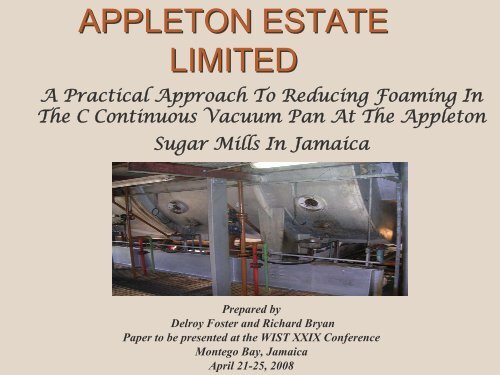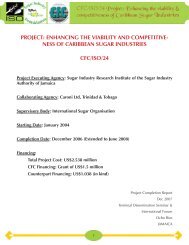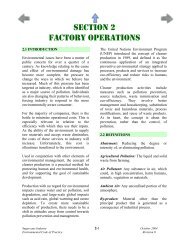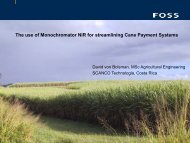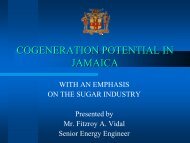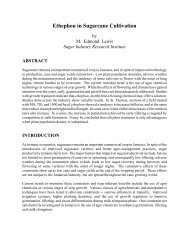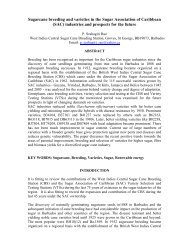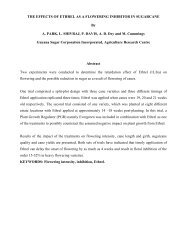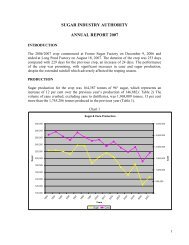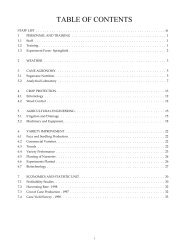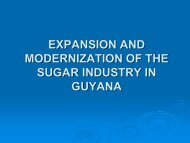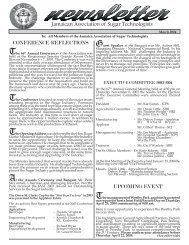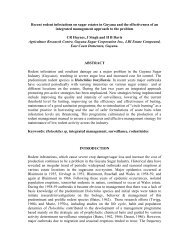A Practical Approach To Reducing Foaming In The C Continuous ...
A Practical Approach To Reducing Foaming In The C Continuous ...
A Practical Approach To Reducing Foaming In The C Continuous ...
- No tags were found...
You also want an ePaper? Increase the reach of your titles
YUMPU automatically turns print PDFs into web optimized ePapers that Google loves.
APPLETON ESTATELIMITEDA <strong>Practical</strong> <strong>Approach</strong> <strong>To</strong> <strong>Reducing</strong> <strong>Foaming</strong> <strong>In</strong><strong>The</strong> C <strong>Continuous</strong> Vacuum Pan At <strong>The</strong> AppletonSugar Mills <strong>In</strong> JamaicaPrepared byDelroy Foster and Richard BryanPaper to be presented at the WIST XXIX ConferenceMontego Bay, JamaicaApril 21-25, 2008
PRESENTATION OUTLINEPRESENTATION OUTLINE Reason for this study <strong>In</strong>troductionGeneralAdvantages of continuous pansReasons for foaming– Chemical– Physical Steps taken and results achievedAssessment of physical conditions<strong>In</strong>itial actions to reduce foamingActions to prevent carryoverActions to prevent carryover entering effluent streams<strong>Continuous</strong> use of an anti-foam agent Summary Conclusion
Reasons for Study1. Sugar losses being incurred when foaming occursand the potential loss of earnings.2. Environmental threat being posed by thecontamination of effluent streams.3. Adverse effects of the contaminated water on theusers of the run off streams adjoining the estateproperty.4. Potential damage to the image of the company bothlocally and internationally.5. Part of our efforts to comply with the NationalEnvironmental Planning Agency’s (NEPA)environmental standards.
<strong>In</strong>troductionGeneral• <strong>Continuous</strong> pans are now becoming a feature of modernsugar factories.• Two continuous pans at Appleton for A and C duties• Pans operated continuously will provide many advantageswhen compared to batch pans.• If pans are not operated continuously, some of theseadvantages can actually become headaches.• Pans at Appleton have performed fairly well when operatedcontinuously.• With frequent stops and starts there is the tendency forfoaming to occur, especially when starting the C pan.
<strong>In</strong>troduction cont’dSome advantages of <strong>Continuous</strong> pans1. Better plant utilization. <strong>The</strong>y occupy 50 – 60% less plantspace.2. Improved steam economy – <strong>The</strong> low boiling head allowslower grade second and third vapour to be used.3. Pans stay on line for long periods (2 weeks for A pans andmonths for C pans).4. Quantity of steaming outs, frequency of shutting downand starting up of pan reduced, cutting of pans lessened.5. Risk of carryover reduced because of less cutting andfilling up.6. <strong>The</strong> constant condensor water demand means that lesswater is needed
<strong>In</strong>troduction cont’dReasons for foaming<strong>Foaming</strong> is not the result of fermentation and istherefore not due to the activity of bacteria or othermicro-organisms (Meade-Chen 1 ).<strong>Foaming</strong> may be spontaneous in pans or may occurhours after in crystallisers – also described as “frothfermentation”.Factors causing foaming are both chemical andphysical.No chemical analyses have been done at Appleton toascertain foaming components.Some of the physical conditions are however, typicalof those that have been found to promote foaming.Significant foaming at Appleton has been observed insyrup, molasses and massecuites.
<strong>In</strong>troduction cont’dPhysical factors causing foaming‣Occurs when low grade massecuitesare heated over 69 o C (156 o F).‣Occurs when molasses is heatedabove 40 o C (104 o F) after leaving thecentrifugal(Meade-Chen 3 ).
STEPS TAKENAssessment on physical conditions that have beenfound to promote foaming• Physical conditions of temperature and vacuumat which low grade massecuite were boiled,were noted.• Comparisons were made with conditions thatare known to promote foaming.• Similar information was gathered for molassesused to boil C massecuite.
Results of physical monitoringTable 1 – Physical conditions during boiling of the C massecuiteCalandriaPressure(psia)Bodypressure(“Hg)Massecuitetemp ( o F)Cell 2Massecuitetemp ( o F)Cell 4Massecuitetemp ( o F)Cell 5Massecuitetemp ( o F)Cell 7Massecuitetemp ( o F)Recommended16 23 162 165 172 172
<strong>In</strong>itial steps to reduce foamingActions• Water was sprayed on massecuite vianozzles that were part of pan design.• 250ml of anti-foam was added to eachcell approx. two hours prior to a plannedshutdown of pan.• <strong>The</strong> same quantity was used duringraising of vacuum on starting up of pan.
Steps to prevent carryoverOriginal pan design•<strong>In</strong>itial take off of vapour wastoo low.•Carryover was occurring too easily.Fig. 1 - <strong>Continuous</strong> C pan – showing point of original take off of vapourFig. 2 - <strong>Continuous</strong> C pan showing vapour take-off - modifiedModified pan design• This was modified to include saveallwith three sets of bafflles spaced 14”apart. Vapour taken off 50” higher•Reduction in quantity of carryover.•Carryover was still a concern.
Steps to prevent carryover cont’d<strong>In</strong> addition to modification to pan design, strict start up and shut downprocedures were instituted.Start upVacuum raised slowly –injection water control valve set at 20%.Discharge valve from pan to be openedMore vigilance around C pan with senior personnel on location.Shut downLowered the level of massecuite in pan to approximately 9”below the top tube plate.We deviated from the initial recommendation of lightening thepan prior to a prolonged shutdown, by actually maintaining ahigher brix.
Steps to prevent carryover cont’d• ResultsFurther reduction in the incidence of carryoverSome adverse effects were noted as a resultof these measures.
Steps to prevent carryover cont’dAdverse effects as a result of actions<strong>Reducing</strong> massecite levels to 9” below tube plate considered lowand resulted in lengthy delays before massecuite dischargeon starting.Receiver space sometimes limited and it was not alwayspossible to achieve these levels of reduction.Massecuite was often discharged from all cells resulting inhigher than targeted purity material going to crystalliser.This resulted in spikes in final molasses purity.<strong>The</strong> need to have senior personnel attending to the pan start upwas not always practical since this sometimes occurred at oddhours.<strong>The</strong>re were instances when shutdown was impromptu and steamwas not available to tighten the massecuite.
Steps to prevent sugar material entering run off streamsCondensor leg-pipe from the C continuous panwas modified to include a ditching well Fig. – 3.Ditching wellOperating wellFigure 3 <strong>Continuous</strong> vacuum pans condenser leg - pipe arrangementControl valves installedin the leg pipes to thesewells were connected tosignal lights on the panfloor to clearly indicatewhether the system wasin the ditched oroperational positionAt start up the waterexiting the condensorwas diverted to theditching well<strong>The</strong> drain from the wellswere separated so thatin the event of acarryover, this would notend up in the maineffluent stream
Steps to prevent sugar materialentering run off streams• A conductivity probe was installed inejection water return to main effluentstream• An alarm was set up on computer screenon page for continuous pan• A buzzer was installed to alarm ifconductivity in ejection stream went abovenormal levels
Steps to prevent sugar material entering run off streamsResults‣System worked satisfactorily‣<strong>The</strong>re was an incident when control valvemalfunctioned causing both control valves toremain open.‣Signal lights installed to indicate valvepositions, have since worked‣No carryover from C pan as a result of foamingsince‣Conductivity and buzzer system have allowedquick detection of any carryover and prompt actionto limit sugar material entering main effluentstream (Figure 4 &5) Pan carry over
<strong>Continuous</strong> use of anti-foam agentMonitoring of anti-foam addition‣Anti-foam was added continuously to Bmolasses header tank at rates between 33and 51ppm/B molasses over a period of45 days‣Addition was monitored daily and weeklyaverages calculated
Monitoring of continuous dosing of anti-foamTable 2 – Dosage levels for anti-foam agentWeek# Anti-foam(ppm cane) Anti-foam(ppm/B molasses1 2.33 412 2.13 333 1.56 334 2.35 395 2.20 406 3.23 517 2.85 50Average 2.34 41‣<strong>The</strong> average dosing of between 33 and 51 ppm/B molassescompares with the recommendation of between 20 and 100 ppm‣Actual dosages were determined by observing the absence offoaming on molasses surface when anti-foam was applied (Fig. 6and 7) Slide 31
Undetermined losses Monitoring• Undetermined losses were monitored andcomparisons made with the previousperiod of 24 days when there was nocontinuous addition of anti-foam
<strong>Continuous</strong> use of anti-foam agent results cont’dAlthough we have not been able to quantify the exact amount ofsugar losses attributed to carryover, there was a reduction inundetermined losses during the period when anti-foam was usedcontinuously (Fig. – 8)UNDET.LOSSESUNDETERMINED LOSSES/JUICE(%)1.61.41.210.80.60.40.201.37NO ANTIFOAM1.14ANTI-FOAMUNDET.LOSSESFig. – 8 Undetermined losses during and prior to anti-foam usage
Operating Time efficiency Monitoring• Comparisons were made with operatingtime efficiency during and before thecontinuous use of anti-foam
<strong>Continuous</strong> use of anti-foam agent results cont’d<strong>The</strong> reduction in undetermined losses was observed despite the factthat operating time efficiency for the factory (Fig. – 9), was much lowerduring the period of anti-foam usageGROSS TIME EFFICIENCYGROSS TIME EFFICIENCY (%8482807876747282.81NO ANTIFOAM76.8ANTI-FOAMGROSS TIMEEFFICIENCYFig. 9 – Gross operating time efficiency before and during anti-foam usage
Monitoring stops and starts of C pan<strong>The</strong> number of stops and starts of C pan were notedduring and before the continuous use of antifoam.‣ Before the continuous use of anti foam– <strong>The</strong>re were six recorded stops and starts of C pan over a periodof 24 days– <strong>The</strong>re were three reported incidents of carryover from C pan as aresult of foaming‣ During continuous use of anti-foam– <strong>The</strong>re have been nine stops and starts of C pan– <strong>The</strong>re was no recorded incident of carryover from the C pan
<strong>Continuous</strong> use of anti-foam agent results cont’d<strong>The</strong> following stringent measures were relaxed in order to assess theeffectiveness of the continuous addition of the anti-foam:Actions‣Vacuum was raised quickly instead of slowly‣Spraying of water on massecuite was discontinued‣<strong>The</strong> level to which the massecuite was lowered was varied with the view ofreducing sameResults‣Vacuum is being quickly raised on C pan with much less fear of carryover‣It is no longer necessary to spray water on massecuite‣Massecuite level is now reduced to between four and six inches below top tubeplate‣No longer necessary to have senior persons attending to C pan on starting‣Operating personnel are reporting greater ease in starting C pan without thesame fear of carryover
Summary‣ Reviewed factors that have been reported to cause foamingChemical and Physical‣ Compared these factors with some of our operating conditionsFocused primarily on physical conditions‣ Looked at initial measures taken to reduce foamingUse of water spraysShock addition of anti-foam agent‣ Looked measures to prevent carryoverModifications to vapour take off<strong>In</strong>stitution of strict start up and shut down of C pan‣ Looked at measures to prevent carryover entering run off streamsModifications to condensor leg pipe<strong>In</strong>stallation of Conductivity system with alarms‣ Employed the continuous use of an anti-foam agent
Conclusion<strong>Practical</strong> methods have given satisfactory resultsModification to vapour take off, lowering of massecuite levels andtightening of massecuite have made major contributions to dealing withthe problem<strong>The</strong> continuous use of the anti-foam has allowed the relaxing of someof the stringent measures that were adoptedAs part of future work, we intent to try and identify the chemicalcomponents that are contributing to foaming at AppletonCertain modifications will be made this off season to deal with anycarryover from batch pansIt was the combined effort of practical measures plus the continuoususe of the anti-foam that have helped to deal with the problem
THE END
Normal conductivity – 411mS/cmDetection of carryover lasted nine minutesConductivity reading - >936 mS/cmFig. 4 – Conductivity reading showing carryover before alarms were installedDetection of carryover lasted 4.5minutesFig. 5 – Conductivity reading showing carryover after alarms and buzzer system were installed Slide 19
Saponin‣ Saponins are glycosides of hydrophobicalcohols which form frothy, soapy solutions.Aqueous saponin solutions have very littlesurface tension‣ Sugars containing 0.4mg/kg of saponin alwayslead to foaming of their solutions‣ Most work done on saponin in beet and whitesugar‣ <strong>In</strong>troduction cont’d
Physical condition causing foaming‣<strong>Foaming</strong> occurs when molasses isheated above 40 o C (104 o F) afterleaving the centrifugal. Slide 10
<strong>Continuous</strong> use of anti-foam agent results cont’dFig. 6 – <strong>Foaming</strong> on Molasses surface with no anti-foamFig. 7 – No foaming on malasses surface, anti-foam added<strong>Continuous</strong> use of anti-foam – Dosage monitoring


